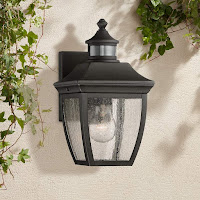 |
| Interesting, naturalistic window grille that does the job just as well, but with a less threatening look. |
“You don’t have to do that here,” she said.
Alas, few places in the U.S. are as safe as Erie, Indiana. Most of us do have to worry about unwelcome guests, not just in our cars, but in our homes as well. As if that wasn’t bad enough, however, some of the things we do to make ourselves more secure have their own bad side effects.
 |
| Window grilles installed on the inside face of windows. Remember that grilles on bedroom windows, whether inside or outisde, MUST be openable to allow escape in case of fire. |
 |
| Contemporary window grille fabricated to look like a traditional wrought iron detail. |
• If you need security grilles on your windows, consider installing them on the interior rather than the exterior. They’ll be less visible from the street, and they can be partly screened by drapes or sheers on the inside. It’s also harder for a burglar to unscrew the grille mounting bolts when they’re inside the house.
An important caveat: Remember that grilles on bedroom windows have to be openable so that occupants can escape in case of fire.
• It's usually best to avoid grilles with a lot of decorative curlicues, since they just draw undue attention. For the same reason, consider painting grilles white or the same color as your window trim instead of the usual wrought-iron black. The grille fabricator can spray them with a rust-resistant primer, leaving you to put on the final color. If you already have grilles installed, consider repainting them the next time you paint your house.
 |
| Your standard-issue motion-sensing security lamp. . . |
• If you want a little extra protection but hate the whole idea of using security grilles, one of simplest, cheapest, and least obtrusive ways to deter prowlers is to install exterior lighting activated by motion detectors. Since the lights only come on when there’s movement outside, they save electricity, and they won’t keep the neighbors awake by burning all night. They also turn off automatically during daylight hours. They’re available at very reasonable cost in any hardware store.
 |
| . . . and a much more appealing version that cleverly integrates the motion detector in the hood. (Image courtesy Lamps Plus) |













